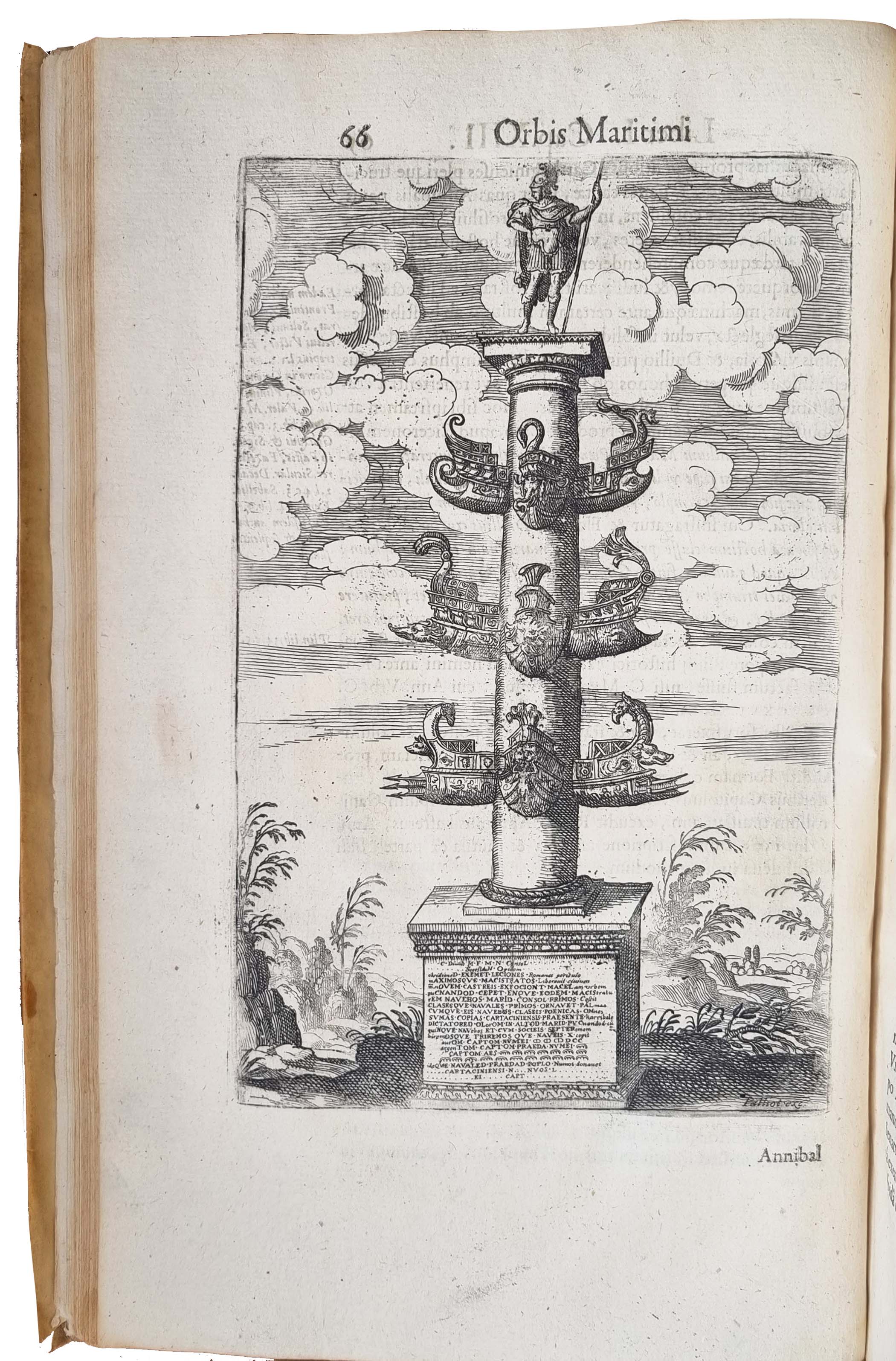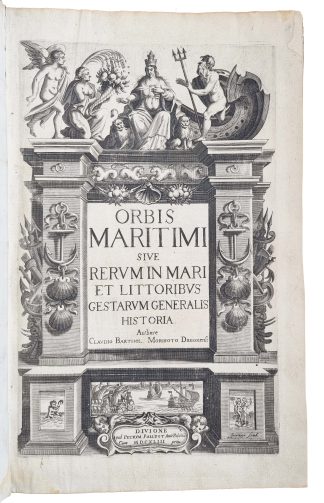MORISOT, Claude Barthélemy.
ILLUSTRATED ENCYCLOPAEDIA OF NAVIGATION
MORISOT, Claude Barthélemy. Orbis Maritimi sive rerum in mari et littoribus gestarum generalis historia.
Dijon, Pierre Palliot, 1643.£4,500.00
FIRST AND ONLY EDITION. Folio. pp. [24], 725, [19] + 1 folding plate, a<sub>4</sub> (cancelled) and ã<sub>1</sub> (dedication) inserted as singleton. Roman letter, with Italic. Engraved architectural title with personification of Dijon, marine deities and creatures, anchors, shells and ships, title in red and black, folding plate with engraved ancient ‘naumachia’ (battle of ships), 1 full-page and 17 ½-page or smaller engraved ancient monuments and coins, and 23 ½-page maps of the ancient world including a T-O map-style planisphere, decorated initials and ornaments. The odd marginal printer’s offsetting. A fine copy, crisp and clean, in contemporary vellum over boards, yapp edges, early title to spine, early ms ‘303’ to front pastedown, C19 ‘table Z’ in red crayon and ‘Rarum opus Lalthenü(?) Bibl. N.661’ to ffep.
A fine copy, crisp and clean, of the first and only edition, first issue, of this lavishly illustrated Americanum – ‘the first naval history […], a veritable naval encyclopaedia’ (Borba de Moraes). The French Neo-Latin poet Claude Barthélemy Morisot (1592-1661) is especially renowned for his alchemical allegory. ‘Orbis Maritimi’ is an encyclopaedia of the sea, navigation, maritime customs and folklore – a fundamental source on maritime law, like Cleriac’s (1647), and travel. Book I is devoted to ancient times, prefaced by a handsome engraving of an ancient ‘naumachia’, a popular spectacle, whereby a theatre was flooded and small ships faced one another in a choreographed battle. The account begins with the obscure origins of navigation and the invention of ships, ancient myths of navigation (e.g., Jason), the most important ancient Greek and Roman sea battles, with observations on the kinds of vessels used, how victors at sea were honoured on return, and maritime spectacles staged in ancient cities. The section on ancient hydrography is a description of the seas, coasts and coastal cities of antiquity, based on ancient sources and providing the modern equivalent of historic place names. It is illustrated with several half-page maps, based on De Bry, including the Iberian peninsula, Britain and Ireland, sundry parts of Africa, the Middle East, Asia and Greece. Book II proceeds through the medieval period, analysing major sea battles by the Gauls, Normans, Britons, Germans, Russians, Poles, and so on, down to Morisot’s times. A couple of sections focus on England, with a summary of key maritime battles since antiquity, and a discussion of C16 maritime policy (e.g., Thomas Seymour as Lord Admiral), voyages (e.g., Francis Drake and Raleigh in the Americas), and early colonies (e.g., Thomas Gates and Thomas Hamond in Virginia, and the establishment of Nova Scotia). Morisot continues with a critique of John Selden’s ‘Mare Clausum’, a theory of territorial waters. Morisot provides illustrations of medieval or contemporary coins or medals representing the king or emperor through maritime iconography. Among the numerous voyages that are mentioned are also Columbus’s 1492 voyage, followed by Spanish explorations of South America, de Veer’s expedition to the Antarctic, Magellan’s explorations in the southern hemisphere, and Portuguese travels in Brazil and Asia. The accounts are factual and detailed, peppered with anecdotes and maritime folklore. A handsome copy.
USTC 6810141; Sabin 50723; Borba de Moraes II, pp.597-8; JFB M496; Alden 643/85: ‘Chapt xvii, Anglorum de moti gestae, chapt. xx, ‘Imperiorum Hispaniorum maritimum’, & chapts xxxiv-xxxvii deal with American matters’.In stock








